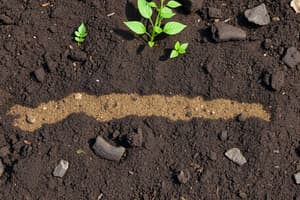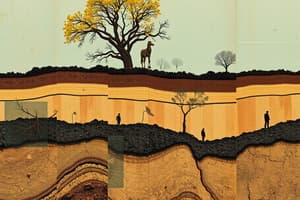Podcast
Questions and Answers
What are the primary factors driving the formation of soil?
What are the primary factors driving the formation of soil?
Weathering of rocks driven by natural processes like water, wind, and temperature changes
How do living organisms contribute to soil formation?
How do living organisms contribute to soil formation?
Living organisms contribute organic matter and facilitate the decomposition of plant remains and animal waste.
What is the O-horizon of soil and what are its characteristics?
What is the O-horizon of soil and what are its characteristics?
O-horizon is the topsoil layer rich in organic matter, supports plant growth, and is high in fertility.
What are the distinct layers of soil called?
What are the distinct layers of soil called?
How does climate influence soil formation?
How does climate influence soil formation?
What is the primary source of the O-horizon in soil?
What is the primary source of the O-horizon in soil?
Describe the role of the B-horizon in soil.
Describe the role of the B-horizon in soil.
What is the defining characteristic of clay soils?
What is the defining characteristic of clay soils?
What makes loamy soils ideal for agriculture?
What makes loamy soils ideal for agriculture?
Explain one environmental protection role of soil.
Explain one environmental protection role of soil.
Flashcards are hidden until you start studying
Study Notes
Understanding Soil: Formation, Layers, Types, and Uses
Soil is a complex natural body that lies at the interface between Earth, air, water, and life. It is a vital resource for supporting plant growth, providing habitats for a wide array of organisms, and serving as a repository for vast quantities of carbon and other nutrients. In this article, we will explore four key aspects of soil: its formation, layers, types, and uses.
Soil Formation
Soil is primarily formed from the weathering of rocks, driven by various natural processes, such as water, wind, and temperature changes. These processes cause rocks to break down into smaller pieces, which gradually transform into the mineral components of soil. Living organisms, including plants, animals, and microbes, play a crucial role in soil formation by contributing organic matter and facilitating the decomposition of plant remains and animal waste. Climate also influences soil formation, as warmer and moister conditions accelerate both weathering and organic decomposition.
Layers of Soil
Soil consists of several distinct layers, or horizons, each with unique properties and functions. These horizons are stacked vertically to create a soil profile. From the surface downward, the primary horizons are typically:
O-horizon: Topsoil
This layer is rich in organic matter, supports plant growth, and is generally high in fertility. It is composed of decaying plant and animal remains and is inhabited by a variety of organisms, such as earthworms and microbes.
A-horizon: Subsoil
Just below the O-horizon, the A-horizon contains less organic matter but still supports plant growth. It is the uppermost layer not directly derived from the O-horizon and is typically enriched with nutrients leached from the O-horizon.
B-horizon: Subsoil
The B-horizon is located below the A-horizon and is often more compact and dense compared to the O- and A-horizons. It contains less organic matter and serves as a reservoir for certain minerals and metal salts, such as iron oxide.
C-horizon: Saprolite
The C-horizon, also known as saprolite, is composed of broken bedrock and lacks significant amounts of organic matter. It represents the transitional zone between the soil and the underlying geologic rock material.
Types of Soil
There are many types of soil, classified based on their composition, structure, and properties. Some common examples include:
Clay soils: These soils contain a high proportion of clay minerals, which can make them highly plastic and prone to expanding and contracting with changes in moisture levels.
Sandy soils: Consisting largely of sand-sized particles, these soils tend to be well drained and can support strong plant growth.
Silty soils: Similar to clay soils but with finer particles, silty soils often exhibit intermediate drainage properties and susceptibility to erosion.
Loamy soils: A mixture of clay, sand, and silt, loamy soils strike a balance between water-retention capacity, drainage, and nutrient supply, making them ideal for agriculture.
Uses of Soil
Soil is vital for agriculture, serving as the foundation for growing fruits, vegetables, grains, and livestock feed. It also provides habitat and food sources for various wildlife species and contributes to biodiversity. Additionally, soil plays a critical role in environmental protection, filtering and absorbing pollutants, mitigating floods and droughts, and sequestering atmospheric carbon. Human activities, such as construction and urban development, require careful handling of soil to maintain its quality and sustainability.
Studying That Suits You
Use AI to generate personalized quizzes and flashcards to suit your learning preferences.




